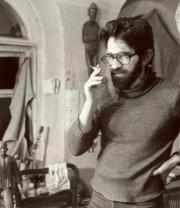
Born to the family of a professor engineer, Bruskin graduated in 1968 from the department of decorative and applied arts of the Moscow Textile Institute. He joined the Union of Artists USSR the following year. He embarked on a successful career in the liberal wing of the official Union of Artists. A repeating subject of this paintings in that period was a surreal motif of sculptures coming alive and stepping down from their pedestals.
In 1987, Bruskin grew close to the circle of Conceptual and Sots artists—Dmitri Alexandrovich Prigov, Lev Rubinstein, Boris Orlov, and Rostislav Lebedev. He participated in their shows at Kashirka, a regional exhibition hall on the southern outskirts of Moscow, where free art was shown in the Perestroika era. An amazing and unexpected success came to Bruskin in 1988, determining the course of his career and fate. His “Fundamental Lexicon” was sold for a record price at the first, pilot Sotheby’s auction in Moscow. That same year he left for the USA and settled in New York in 1989. Bruskin is one of the most successful Russian artists in the gallery and collector world. At the request of the German government, his paintings were exhibited in one of the halls of the renovated Reichstag in 1999. He is the author of several books devoted to the Brezhnev stagnation period and its culture.
His art belongs to late Sots Art, where monumental and decorative tasks prevail over conceptual ones. With talent, he summated and appropriated the main themes of Moscow Conceptualism (a catalog of totems and characters of the Soviet world from Orlov and Lebedev) and took up the methods of conceptual analysis and systematization of the Soviet cosmos in the form of tables, catalogs, and lists (from Prigov and Kabakov). He embodied this material, which the Conceptualists themselves frequently left only in draft “nonspectacular” form, in effective entertaining works and in art design. He led Sots Art into a traditional art form that was properly appreciated by the market. Bruskin’s work logically completes the trajectory of nonconformist art, which began an as emotional protest against tradition, continued as a conceptual game with it, and finished in a new union with it. Bruskin’s paintings and sculptures are related to mature Sots Art the way that the work of the color cubists of the Section d’or are related to the works of Picasso and Braque.
All of Bruskin’s work is devoted to the reminiscences of the vanished Soviet civilization. The more time passes, the more the Soviet heroes of his “Fundamental Lexicon”—Pioneers, workers, engineers, teachers—are diluted with characters from contemporary globalized mass culture, moving into his works from film serials and computer games.